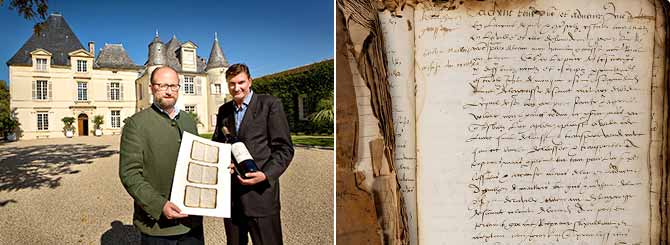Date£º
2014-10-09 11:41 Source£º
winesearcher Author:
Wine-Searcher staff Translator:
New historical evidence proves that great Bordeaux terroir was highly valued in the 16th century.

?Domaine Clarence Dillon; Archives Departementales de la Gironde | Prince Robert of Luxembourg, owner of Chateau Haut-Brion and historian Laurent Chavier; original document from the Gironde archives
Domaine Clarence Dillon, owner of Chateau Haut-Brion, has released details of two new historical references proving that vineyards on the same site as the chateau were producing good wine nearly 500 years ago.
Chateau Haut-Brion has always been considered as the oldest of the First Growths, and as a Graves, was the only non-Medoc wine to be included in the 1855 classification. It was famously mentioned by the London diarist Samuel Pepys in the 17th century, and there was an earlier mention of Haut-Brion wine dating from 1660 in the cellar book belonging to England's King Charles II.
In May 2013, Prince Robert of Luxembourg, the managing director of Domaine Clarence Dillon, issued a challenge to historians to see if they could find any even earlier references. The challenge was met by historian Laurent Chavier and the results of the research has now been released.
The earliest mention is in a notarial document, contained in the archives of the Gironde department, dated 21 January 1521. It relates to the sale of an annuity or loan in return for an annual "payment" in wine.
Jean de Monque agrees to deliver each year: "four pipes of wine ... from the vineyard (cru) belonging to the said de Monque from the place known as Aubrion, belonging to the said seller. The said vines being found behind his smallholding established in the said place known as Le Brion, in the parish of Saint-Martin de Pessac ?all belonging to the said lord of Monque, domiciled in Graves in Bordeaux ?
The buyer or lender is Guilhem de Mailhois, a bourgeois and merchant of Bordeaux; the seller or borrower is Jean de Monque, a squire and lord of the village of Monque.
The four pipes were the equivalent of eight barriques or 1800 liters (475 gallons) and had to be transported to de Mailhois's smallholding which was known as Au Bryon. The document also states that wine made from other vines was not allowed to be substituted, indicating that terroir was already valued.
The second historical reference, that has been unearthed from the same archives, is dated 1 September 1526 and concerns a sale of wine: "two barrels of clairet or red wine from the vineyard of Haulbrion [sic] in Graves." This would have been a sale on the vine prior to harvest, therefore it would not yet have been known if the wine would have been pale colored (clairet) or dark colored (red). It had to be delivered before 29 September so there would have been no chance for a long maceration. In those days "the newer the wine, the better ..."
This second reference helps confirm the first since it refers to wine from the same specific place. Both references occurred before Jean de Pontac of Bordeaux purchased the noble estate of Haut-Brion in 1533. It indicates that he already knew that he was buying a property with the potential of producing fine wine.
After five centuries, the chateau's wines are still highly valued. According to Wine Searcher's database Chateau Haut-Brion is the eight most searched-for wine, it achieves an average score of 90/100 and sells for an average price of $591.